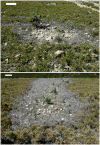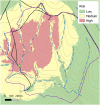Topographic effects on dispersal patterns of Phytophthora cinnamomi at a stand scale in a Spanish heathland
- PMID: 29601576
- PMCID: PMC5877875
- DOI: 10.1371/journal.pone.0195060
Topographic effects on dispersal patterns of Phytophthora cinnamomi at a stand scale in a Spanish heathland
Abstract
Phytophthora cinnamomi is one of the most important plant pathogens in the world, causing root rot in more than a thousand plant species. This observational study was carried out on a P. cinnamomi infected heathland of Erica umbellata used as goat pasture. The patterns and shapes of disease foci and their distribution were described in a spatial and temporal context using an aerial photograph record. A set of topographic traits was selected on the basis of a disease dynamic hypothesis and their effects on observed spatial disease patterns were analyzed. Incipient infections situated in flat terrain expanded as compact circular front patterns with a low growth rate. On slopes, disease patches developed more rapidly down slope, forming parabolic shapes. The axis direction of the parabolas was highly correlated with terrain aspect, while the parabolic amplitude was associated with land curvature and slope. New secondary foci appeared over the years producing an accelerated increase of the affected surface. These new foci were observed in sites where disease density was higher or near sites more frequently visited by animals such as the stable or the forage crop. In contrast, a smaller number of disease foci occur in areas which animals are reluctant to visit, such as where they have a short range of vision. Our results suggest that 1) the growth of existing P. cinnamomi foci is controlled by a combination of root-to-root contact and water flows, 2) the increase in the diseased area arises mainly from the multiplication of patches, 3) the formation of new foci is mediated by long-distance transport due to the movement of animals and humans along certain preferential pathways, and 4) geomorphology and topography traits are associated with the epidemiology of this soil-borne pathogen.
Conflict of interest statement
Figures








References
-
- Lowe S, Browne M, Boudjelas S, De Poorter M. 100 of the World’s Worst Invasive Alien Species A selection from the Global Invasive Species Database. The Invasive Species Specialist Group. World Conservation Union (IUCN) 2000
-
- Burgess TI, Scott JK, McDougall KL, Stukely MJ, Crane C, Dunstan WA, et al. Current and projected global distribution of Phytophthora cinnamomi, one of the world’s worst plant pathogens. Global Change Biology. 2017; 23(4):1661–1674 doi: 10.1111/gcb.13492 - DOI - PubMed
-
- Shea SR, Shearer BL, Tippett JT, Deegan PM. Distribution, reproduction, and movement of Phytophthora cinnamomi on sites highly conducive to jarrah dieback in South Western Australia. Plant Disease. 1983; 67(9): 970–973
-
- Brasier CM. Oak tree mortality in Iberia. Nature. 1992; 360: 539
-
- Robin C, Desprez-Loustau ML, Capron G, Delatour C. First record of Phytophthora cinnamomi on cork and holm oaks in France and evidence of pathogenicity. Annales des sciences forestières, 1998; 55 (8): 869–883
Publication types
MeSH terms
LinkOut - more resources
Full Text Sources
Other Literature Sources

